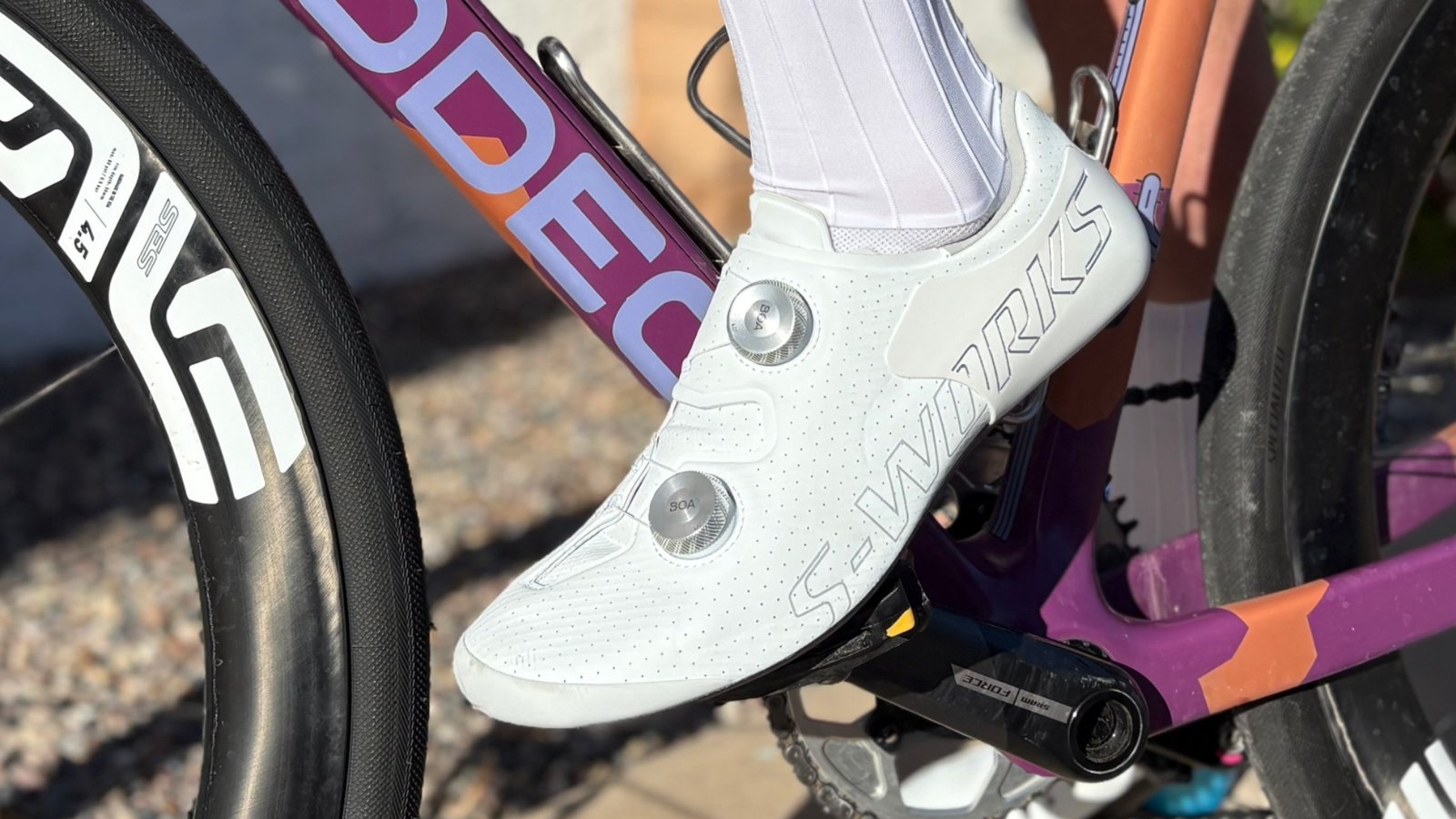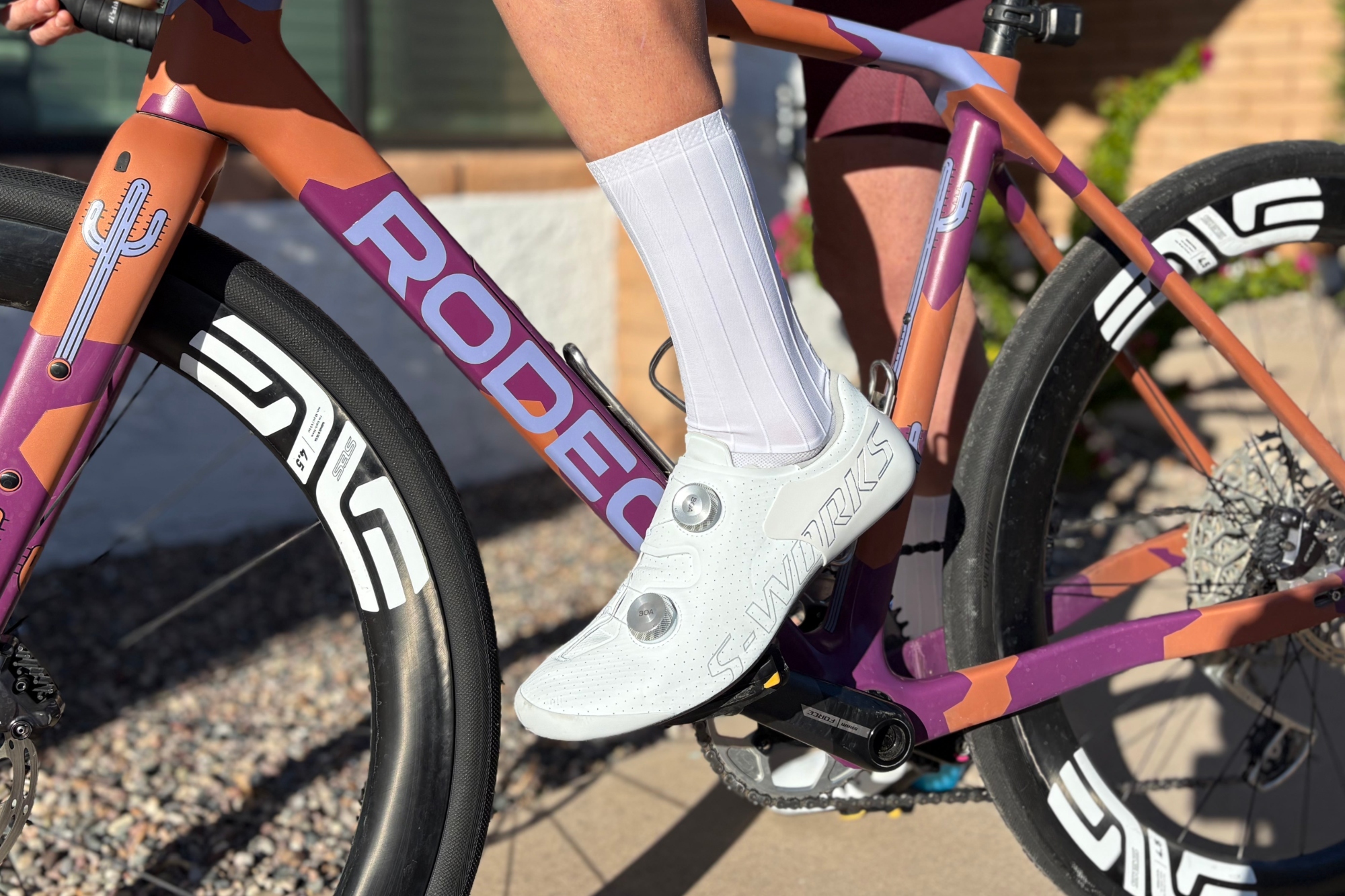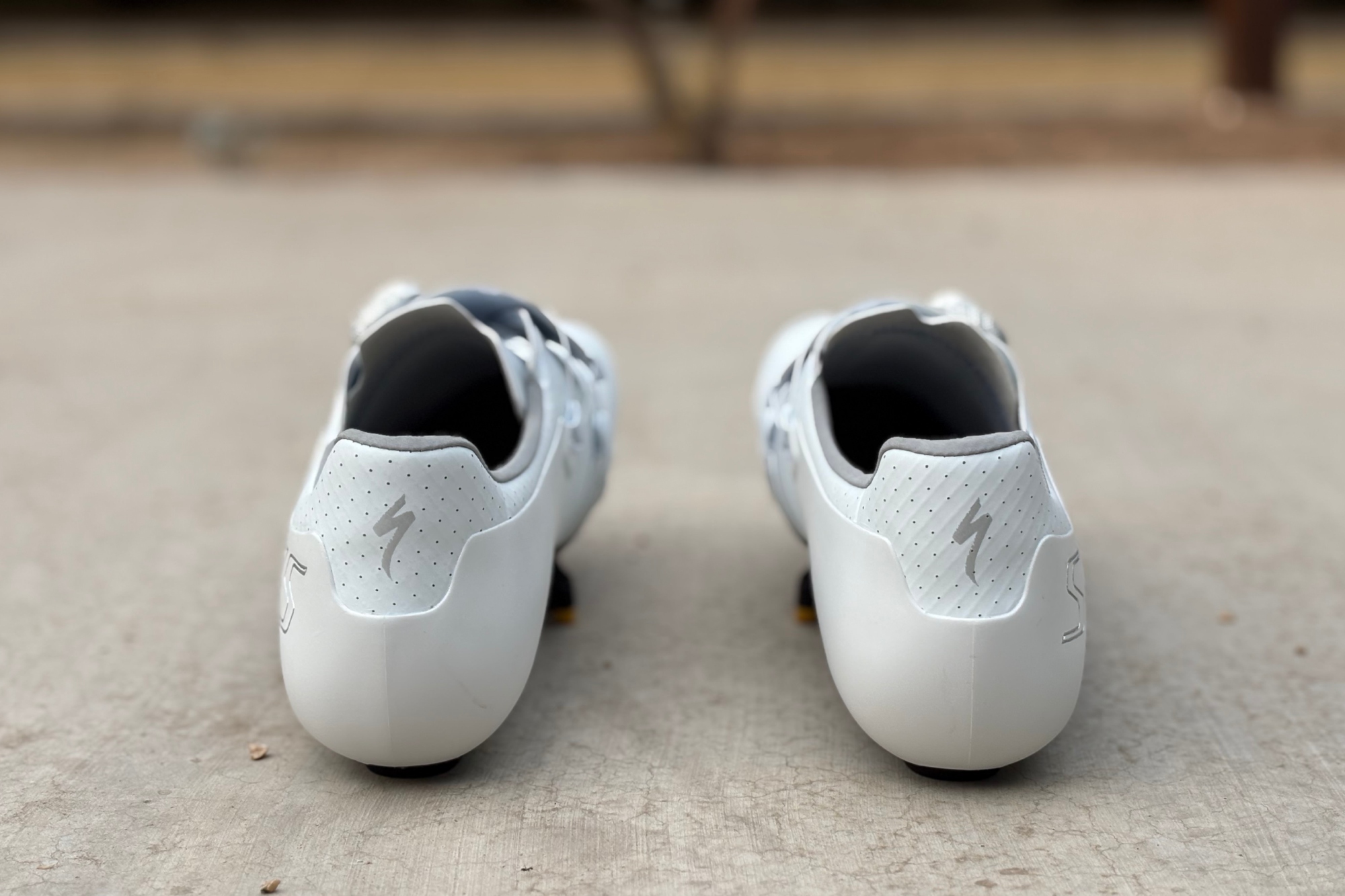
Specialized has long established itself as a leading brand in the bike industry, known for its extensive and diverse range of high-quality bicycles. Yet, the brand’s slate of components and accessories may just be more popular than the bikes themselves. The brand’s tyres, shoes, helmets and saddles are everywhere — I dare you to show up at a group ride just about anywhere in the world and not find Specialized-branded items. Thus, when Specialized updates its top-end shoe range, it’s worth noting.
The brand’s latest release is a refined version of the previous Ares shoe — Specialized’s top-of-the-line road cycling shoe, worn by the likes of Primoz Roglić, Demi Vollering and Tim Merlier.
The updated Ares aims to enhance comfort and ergonomics—factors Specialized identifies as crucial for maximising power transfer and reducing localised pressure on key areas of the foot. To achieve these improvements, Specialized says it analysed more than 100,000 3D foot scans to optimise the foot-shoe-pedal interaction and boost overall system efficiency.
“With a complete suite of ergonomically designed, scientifically proven Body Geometry innovations—including the all-new Body Geometry Last—the S-Works Ares 2 eliminates pedal lag and maximises power transfer,” Specialized said in the press kit for the new shoe.
This emphasis on “Body Geometry” has yielded a shoe with a 20% increase in contact surface inside and 44% less forefoot pressure in practice. All things considered, the new shoe provides a claimed seven-watt increase to the rider’s functional threshold power if the rider also uses other Body Geometry products and innovations like refined cleat position and custom footbeds.
Yet, arguably, the most talked-about aspect of the Ares 2 isn’t its construction or updated materials; it is its steep price, which ranges from $450/£375 to $600/£479.
The price of gear is a somewhat touchy subject in gear reviews. On one hand, reviews are an assessment of quality, not necessarily value. Value is, after all, highly subjective. However, when prices are raised by such magnitudes that they potentially shift the cost of the entire product market, it is impossible to ignore. The Ares 2 is a clear-cut example of that.
From the onset of the test, the balance between the shoe’s performance and cost was at the front of my mind as I tried to parse through my ultimate verdict. Fundamentally, the question that kept coming to my mind, and the one that has guided my review, is: What is the cost of a seven-watt gain?
Specs
(Image credit: Logan Jones-Wilkins)
- Model: S-Works Ares 2
- Intended use: road racing
- Outsola: Unidirectional carbon
- Closure: BOA® Fit System featuring Dual-Dial Li2
- Weight: 263g (size 43)
- Size tested: 43
- RRP: $599.99
The Body Geometry of it all

(Image credit: Specialized)
As was the case with the Specialized Torch released last year, Specialized has doubled down on its Body Geometry philosophy, which is based on the brand’s ergonomic research and biomechanical testing to optimise rider fit and performance.
Body Geometry heavily influenced the shoe’s updates, particularly around the potential to maximise power transfer through body alignment and ergonomics.
Specialized breaks it down into four general elements: the Varus Wedge, Metatarsal Button, Longitudinal Arch and Body Geometry Last. These four elements each touch on a different adjustment the shoes make.
Varus Wedge refers to the shoe’s 1.5-degree tilt towards the outside of the pedal. This rotation allows the rider’s knee to track vertically throughout the downstroke of the pedalling motion, allowing for more direct power transfer to the pedals.
Similarly, correcting the engagement of the Metatarsal Button allows the shoe to have a tight fit without pinching the rider’s toes, as a “button” elevates and separates the Metatarsal bones. The “Longitudinal Arch” is the shape of the shoe meant to counteract its tendency to act as a spring, once again increasing power transfer.
Lastly, the increase in the footbed size creates more room for the toes to splay, which increases comfort and diminishes the pressure on the rider’s feet.
All these four elements work together to create what Specialized says is a formula to increase the wearer’s power at lactate threshold by 7 watts. Allegedly.
The Ares 2 tension is controlled by a dual Boa Fit System that incorporates the Boa’s Li2 multidirectional dials. This new and improved system, which is also on the new Giro Imperial II and Fizik Vega Carbon road shoes, provides precise tension adjustment in a two-part system that allows for the upper to contour specifically to different portions of a rider’s foot. The dials themselves have also been upgraded with a new alloy construction, giving the system more durability and a nice silver aesthetic.
This, paired with a much broader and squared toe box, gives a lot of flexibility in where the shoe tightens around a rider’s foot. The Boa dials themselves have also been redesigned to provide more precise tension control while retaining the easy-to-use elements that make the BOA system usable on the go, even in race environments.
Ride feel: strong power transfer versus the ankle problem

(Image credit: Logan Jones-Wilkins)
My first ride in the Ares 2 came a few weeks before the launch in March, and I have been riding consistently in the shoes since, covering everything from long road rides, hill intervals, light gravel rides and even a criterium race. Across the different uses, the shoe was best suited for shorter efforts where acute power transfer is key, especially in sprinting. What I found was that the use cases where the shoe matched what I was looking for were much more limited than I anticipated.
One of the main design elements of the Ares, along with other Specialized shoes, is a high, rigid ankle cup intended to lock the heel and ankle of the rider in place for improved power transfer to the pedals, similar to the goal of the “Longitudinal Arch.” The problem with this design element is that the heel profile results in a unique fit that is a challenge to my anatomy. With the Ares 2, my normal shoe size was unwearable. The impingement was so severe that in the first four rides I attempted with the shoes, I had to stop within the first 45 minutes to release the boa dials to reduce the pinching sensation that made it difficult to pedal.
I ended up swapping sizes down from a 44 to a 43, which alleviated most of the discomfort around the ankle/heel area, but it did create a much tighter fit in the front of the shoe. It was workable with thin socks, and my foot felt very secure. However, the feeling of the shoe’s construction was always on my mind when pedalling.
Every time I changed my cadence or stood up out of the saddle, I would be reminded of the tight heel or the cramped toe box. For shorter rides, the locked-in feeling and solid power transfer would outweigh the fit restrictions. But anything over three hours began to feel like a chore, and I would find myself loosening the Boa-dials at different points to offer a reprieve for different parts of my feet.
As for the seven watts added to my threshold power? Who’s to say? What I can tell you is I was not suddenly adjusting the power zones ascribed to my workouts.
Lastly, the cleat attachment was also strange and limiting, with only minor forward and backwards adjustability. The sliding bolts, which are standard on three-hole cleat designs, did not slide easily. After a while of working on the shoe to get the cleats back in the position I normally use, I was able to find the right location, but it was a challenge and not a task I hope to do again. Beware if you have similar fit demands.
Finding the footing of a new aesthetic

(Image credit: Logan Jones-Wilkins)
The Ares 2 does shine in its aesthetic improvement. The shoe’s overall shape was redesigned to suit more foot shapes, and the result is a striking design.
The pair I tested came in white with silver accents. The white body of the shoe is complete with rubber toe reinforcements, which create a blunted, built-up yet not bulky look that is unique in the market of top-end road shoes, where narrow and sleek designs are ubiquitous. Capping that design off with the “S-Works” logo outlined in silver that matched the Boa dials creates an undeniably striking shoe that matches the bold performance claims of the Ares 2.
While white road shoes are the dominant colour these days, if you plan on making these your everyday shoes or live in a rainy area, these shoes also come in black, green and the “team issue” colourway, which has a bigger “Specialized” logo and black trim. If you do go with all white, the material is easy to clean and has held up well after regular riding, so fear not.
Verdict

(Image credit: Logan Jones-Wilkins)
A simple litmus test I use when evaluating gear is whether using it feels natural or like a chore. Some products seem to have a gravitational pull, and I find myself reaching for them repeatedly, even when other options also need testing. Others I use selectively and with care, making sure their quirks don’t interfere with the kind of ride I want to have.
More often than not, this divide comes down to cost. Cheaper gear is usually not as refined as its more expensive counterparts. But that comparison can be revealing. If I don’t hesitate to use a more affordable option, it’s likely a good value. On the other hand, if I find it hard to set aside the premium version, it might just be worth the upgrade.
What was surprising about the Ares 2 was that:
1) The shoes are significantly more expensive than the alternative shoes in my lineup, even other high-end road performance options, and
2) They’re the shoes I always avoided wearing.
With that said, my experience with the Ares 2 should come with all the appropriate caveats: Ride feel is subjective as everyone’s feet are unique, and value is in the eye of the beholder. Still, my feet are far from abnormal. I have shoes from many different brands that have distinct pros and cons, but they are all wearable. The Ares 2 is the only pair that I fundamentally struggled with. What’s more, they cost over a hundred USD more than most of their direct competitors, and have experienced a massive price hike between iterations.
To me, it feels like Specialized is using the claimed “seven-watt” performance gain both as a marketing tool and as justification for the shoe’s steep price increase. Naturally, achieving those claimed watt-savings required the engineering and design teams to invest time and resources, diving deep into the complexities of shoe construction. The result is a product that is, presumably, very effective for some but completely ineffective for others.
Ultimately, that is a valid approach, as no product will work for every rider. But in this case, a market leader has raised the price of its flagship model so sharply in pursuit of a specific—and for many, imperceptible—performance gain that consumers may be asked to spend considerably more without necessarily experiencing the promised benefits. That shift risks not just diminishing the value of one model but skewing perceptions of value across the entire high-end shoe market.

